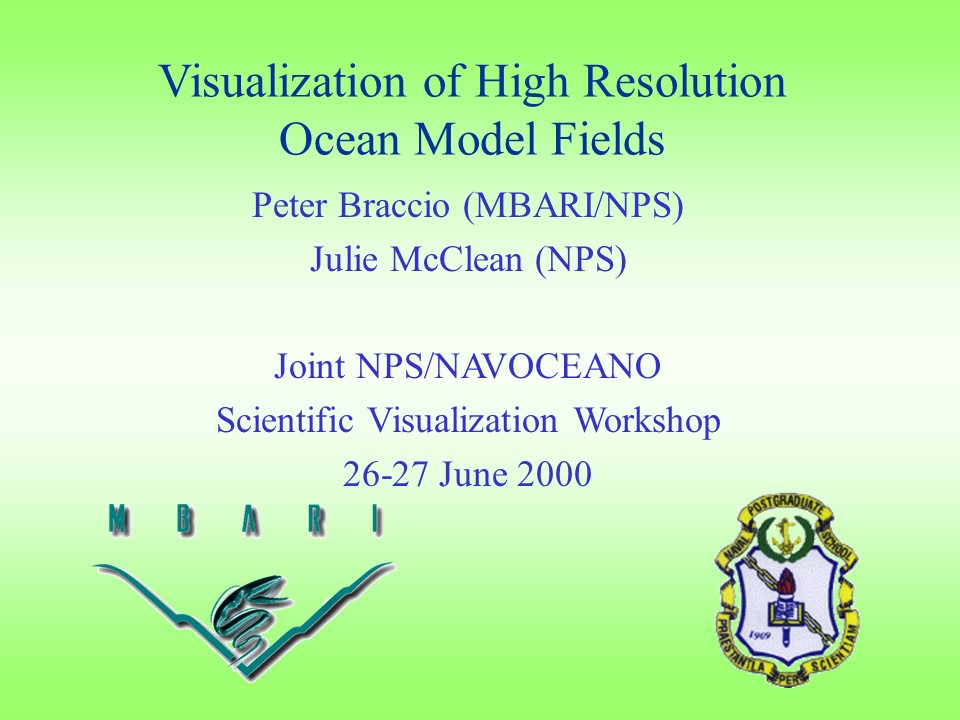Visualization of High Resolution Ocean Model Fields PowerPoint PPT Presentation
1 / 34
Title: Visualization of High Resolution Ocean Model Fields
1
Visualization of High Resolution Ocean Model
Fields
- Peter Braccio (MBARI/NPS)
- Julie McClean (NPS)
- Joint NPS/NAVOCEANO
- Scientific Visualization Workshop
- 26-27 June 2000
2
Collaborators and Acknowledgements
- Mathew Maltrud (LANL)
- Bert Semtner (NPS)
- Jimmy Pelton M.S. thesis (NPS)
- Pierre-Marie Poulain (NPS)
- Funding ONR, NSF, DOE/CCPP
- Computer Resources ARL, ARSC, LANL
- Data AOML, JEDA,WOCE DACs
3
So...
- Youve made spent years developing your computer
simulation. - Youve got your funding.
- Youve been allocated run time and disk space at
a Super Computing Center. - Youve created your input forcing fields.
- Youve run your code and happily used hours of
computer time and terabytes of disk space.
4
Now, what do you do with all this output?
5
Analyze and Visualize
6
As computer simulations have increased in size
and complexity, so have the associated problems
associated with analysis and visualization.
7
State of the Art computer simulations of the
world ocean are running at resolutions on the
order of 1000x1000x40. Ocean models based on
grid dimensions of 3600x2400x40 are already in
the planning stages and will be in production
shortly (July 2000).
8
With the increases in computing power and the
decrease in the price of storage there shouldnt
be any problems in visualizing these models.
However, if that was the case, we wouldnt be
here today.
9
0.1º, 40-level North Atlantic POP Model
Description
- Multilevel PE model Implicit free-surface
- Initialized from 15 yr run with ECMWF forcing
Smith et al., 2000. - Forced with daily NOGAPS wind stresses (93-97)
and Barnier seasonal surface heat fluxes. - KPP mixed layer
- Mercator grid 11 km _at_equator 3 km _at_northern
boundary.
- Topography ETOPO5
- Surface salinity restored to Levitus.
- POP release June 1999
- Source code http//climate.acl.lanl.gov
- Web site http//www.oc.nps.navy.mil/braccio/pop_
eval
10
POP Time-Averaged Variable Options
11
North Atlantic 0.1 POP Output Saved as 3-Daily
Averages (.8 GB per file)
- Sea surface height
- 3D solutions of zonal and meridional velocities
- 3D solution of potential temperature
- 3D solution of salinity.
12
North Atlantic 0.1 POP Output Saved as Daily
Snapshots (76 MB per file)
13
Sea Surface Temperature over the whole model
domain
14
What is the size of the problem?
- Grid size 992x1280x40
- 4 - 3D and 1 - 2D fields are recorded every 3
days - This leads to a .8 Gb file every 3 model days
- -gt 96 Gb of output per model year
- -gt 400 Gb file (formatted for visualization)
- -gt 2 Tb of output for a 5 year simulation
15
Computer systems, storage devices, and software
are not in place (for the average research group)
to visualize this amount of information.
16
Even though we are simulating a 3 dimensional
environment, because of the lack of resources we
usually end visualizing in only 2
dimensions. Using data mining techniques, we
then extract the variables that we deem
interesting for study out of the whole data
set.
17
Simulation of Sea Surface Height Anomaly (cm) for
years 1993-97 mean is removed for this period.
Note the rich eddy field and well-resolved
frontal structures, especially in the Gulf
Stream and the equatorial currents.
18
(No Transcript)
19
North Atlantic 0.1 POP Output Saved as Daily
Snapshots (76 MB per file)
20
Smith et al., 1999
21
(No Transcript)
22
(No Transcript)
23
(No Transcript)
24
(No Transcript)
25
(No Transcript)
26
(No Transcript)
27
(No Transcript)
28
Navy Global Prediction Vision
- A high-resolution global coupled air/ocean/ice
model that assimilates data, providing initial
conditions for forecasts. - Very-high resolution regional coupled models
nested into the global system at key locations.
29
The Future -Global 0.1º,40-level POP
- Initialize using MODAS annual T and S.
- Spin-up for 2 decades force with a climatology
constructed from ECMWF reanalysis (1979-1993) or
NCEP. - Run for 5 years with realistic NOGAPS forcing.
- To be run on IBM SP P3 at NAVO
30
Global Grid Size 3600x2400x40
31
Development and Plans for Other Components of
Global Coupled Predictive System
- Atmosphere NOGAPS (NRL, FNMOC)
- Coupler NRL
- Data Assimilation MVOI or adjoint (NRL, FNMOC,
NPS, OSU) - Ice PIPS (NRL, NPS)
32
Some thoughts on 3D visualization
While system resources often preclude visualizing
in three dimensions, there are other problems
associated with this category of visualization.
33
- Only see the part of the phenomena that is
closest to you. - The depth exaggeration (due to vastly different
scales in the horizontal and vertical) is greatly
pronounced - Choices made when constructing the visualization
have greater impact on it than when visualizing
in 2D (due to the added factors of observer
location and orientation) - Some variables (i.e. subsurface trajectories)
have to be run in the model in order to produce
meaningful results.
34
Conclusions
- All research groups should invest in immersion
visualization technologies (i.e.. Caves) to
display real-time 3D simulations. - Barring that, 2D slices of 3D fields are the way
to go. - Possible solutions are on the horizon, if we can
leverage them.

